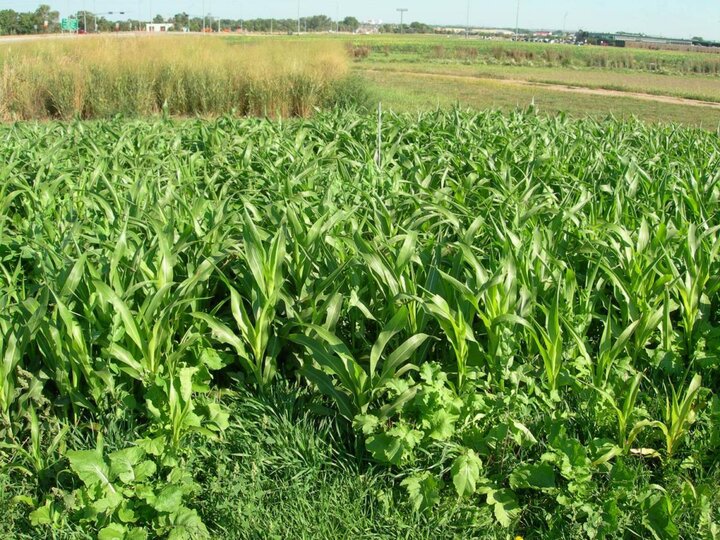Controlling Bluegrass in Irrigated Alfalfa
Bluegrass can be a common weed in irrigated alfalfa lowering forage quality and shortening stand longevity. Fortunately, there are several ways to control these pesky plants such as maintaining thick alfalfa stands, properly managing irrigation and using herbicides (as a last resort).
High-density alfalfa stands can be effective toward competing with bluegrass for sunlight, moisture and nutrients. However, it is important to time irrigation so the upper several inches of fields are dry at harvest. Then, delay irrigation until significant alfalfa regrowth is initiated. Unlike alfalfa that has a deep root system, bluegrass is shallow rooted and will not compete well with the alfalfa if the topsoil is dry. Conversely, early irrigation following harvest may allow bluegrass to out-compete the alfalfa for available surface moisture, since bluegrass basal leaves help it grow more rapidly after alfalfa is cut. Once alfalfa gets some regrowth, it will compete well with the bluegrass.
If thick stands and water management are adequate, then herbicides like Select Max®; Arrow-Post®; Prowl H2O-Post®; Chateau® or Roundup WeatherMax® might be cost effective to weaken or kill bluegrass. Apply any one of these immediately after harvest. RoundUp® herbicides can be used on alfalfa with Round-up Ready® genetics. Select Max® may be the best herbicide for non-Roundup Ready alfalfa varieties and is safe for all alfalfa fields.
Bluegrass is a problem in many irrigated alfalfa fields, but it does not need to be. You can control it.
Grazing with the Weather
Precipitation and temperature play major roles in pasture productivity and knowing how to adjust grazing to match current conditions is key. Are you shifting your management to meet recent weather?
Stocking and grazing management are not static things. When production is limited — especially during a drought period — stretching forage resources is a high priority. By this point in the year, our pastures have produced the vast majority of forage that we will get. Using temporary electric fence to cross fence can increase utilization — slowing down a grazing rotation and stretching forage considerably.
This is especially true when plants become dormant due to lack of precipitation or heat. Typically, utilization seeks to balance animal demand and plant health, but taking more of a dormant plant without damaging the crown has little impact on overall plant health.
On the flip side, grass that is getting tall and lanky ahead of a grazing rotation could benefit from flash grazing. Moving animals on and off quick can help keep plants from getting over mature. Keep up this fast pace while growth is rapid. Once growth slows, then the rotation can slow down as well.
Speeding up grazing when things are wet and slowing down during dry times is a great strategy to use as we adjust to the weather Mother Nature throws our way. Doing so can help you find the perfect balance for your pasture and animal health.
Forage Following Wheat

Wheat harvest will soon be upon us and that leads us to be thinking about some forage opportunities after harvest is complete. There is plenty of growing season left this year and there are several forage possibilities.
If the cropland is not irrigated, receiving some rains after wheat harvest is, of course, going to be necessary to grow that forage crop.
For example, with good moisture an early maturing corn is one possibility for silage if you plant it thick. A better dryland choice might be a high grain-producing forage sorghum, if chinch bugs and other insects are not a problem. Sunflowers can be a surprisingly good choice for a short-season silage. They survive light frost and yield well under many conditions.
If hay is preferred, plant sorghum-sudan hybrids, teff, or pearl or foxtail millet. A hay crop exceeding two to three tons per acre can be grown easily if planted soon after wheat harvest. Another hay or silage alternative is solid-seeded soybeans. A couple tons of good forage can be grown from taller, full season varieties planted after wheat.
Oats planted in late July to early August is another option. Yields over two tons are common when moisture is good, fertility is high and your hard freeze comes a little late.
Definitely consider turnips, as well as oats, for fall pasture planted into wheat stubble in late July or early August. With a few timely rains in August and September, both oats and turnips produce much high-quality feed in a short time, and they are relatively inexpensive to plant.
Don't automatically let your wheat ground sit idle the rest of the year, especially if you could use more forage.
